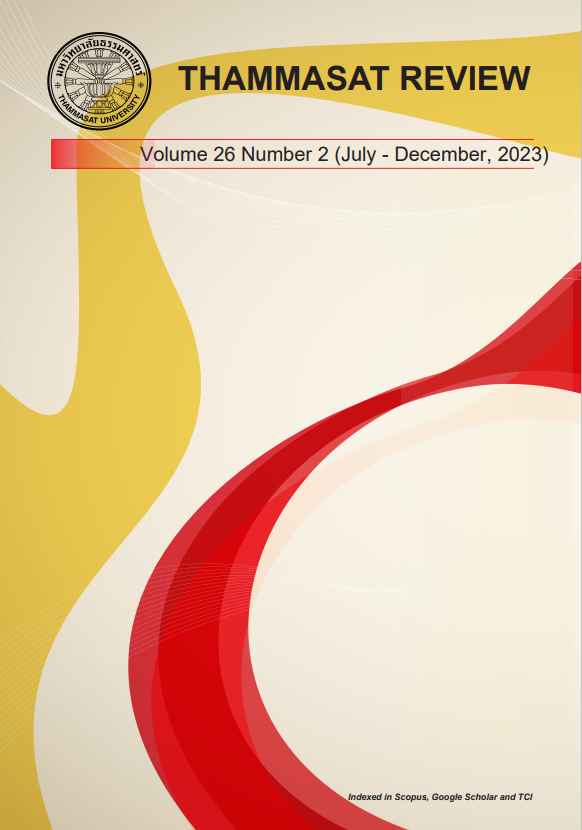Trends in Work-Behaviors: Addressing Work-Related Stress in the Thai Workforce
Keywords:
Quiet quitting, Bailan, Quiet firing, Frugality, Boomerang employeesAbstract
The evolving work landscape has drawn attention, and the World Economic Forum highlights trends impacting the workforce. This study explores five work behavior patterns: quiet quitting, bailan, quiet firing, frugality, and boomerang employees. Quiet quitting involves disengagement, resembling a silent resignation. Bailan reflects deteriorating work and life due to diminished motivation. Quiet firing employs strategies inducing dissatisfaction for cost-saving resignations. Frugality prioritizes work-life balance over excessive wealth. Boomerang employees return to former organizations.
To assess prevalence and factors in Thailand, we conducted a survey with 400 employees aged 18-35. Regression analysis revealed stressors influencing negative work patterns. Quiet quitting resulted from mismatched job assignments, unclear evaluation criteria, limited autonomy, and conflicting ideologies. Bailan was influenced by misaligned tasks, monotonous work, isolation, criticism, and unsuitable environments. Quiet firing correlated with excessive workloads, mismatched tasks, isolation, criticism, neglect, unfair treatment, and conflicting ideologies. Frugality factors included unclear job scope, restricted autonomy, isolation, incongruent ideologies, and insufficient resources. Boomerang employees were affected by misaligned tasks and an unsupportive atmosphere.
The study found moderate to low levels of negative work behaviors among Thai employees. Organizations can mitigate these by addressing stress factors, refining job assignments, establishing clear criteria, fostering autonomy, promoting open communication, and nurturing supportive environments. These measures not only curb negative behaviors but also align with SDG 8, fostering decent work and sustainable economic growth.
References
Alchian, A. A. (1969). Information costs, pricing, and resource unemployment. Western Economic Journal, 7(2), 109-128
Bakker, A. B., & Demerouti, E. (2007). The job demands‐resources model: State of the art. Journal of managerial psychology, 22(3), 309-328.
Barling, J., Kelloway, E. K., & Frone, M. R. (Ed.). (2004). Handbook of work stress. Sage.
Castrillon, C. (2022). 10 Signs Your Boss Is Guilty Of Quiet Firing. Forbes. https://www.forbes.com/sites/carolinecastrillon/2022/09/11/10-signs-your-boss-is-guilty-of-quiet-firing/
Derek T. (2022). Quiet Quitting Is a Fake Trend. The Atlantic. https://www.theatlantic.com/ newsletters/archive/2022/09/quiet-quitting-trend-employee-disengagement/671436/
Gandhi, V., & Robison, J. (2021). The 'Great Resignation' Is Really the 'Great Discontent'. Gallup. https://www.gallup.com/workplace/351545/great-resignation-really-great-discontent.aspx
Harter, J. (2023). Is Quiet Quitting Real? Gallup. https://www.gallup.com/workplace/398306/ quiet-quitting-real.aspx
Hutt, W. H. (1977). The theory of idle resources. Ludwig von Mises Institute.
Kantor, A. (2022). Move Over, Quiet Quitting — Frugality is the Latest Trend in Work-Life Balance. Bloomberg. https://www.bloomberg.com/news/articles/2022-09-09/quiet-quitting-frugality-is-new-trend-as-people-seek-better-work-life-balance
Meenu, B. (2017). Boomerang employees: A good hiring strategy. Bangalore: Amity Research Center Headquarter.
Ni, V. (2022). The rise of ‘bai lan’: why China’s frustrated youth are ready to ‘let it rot’. The Guardian. https://www.theguardian.com/world/2022/may/26/the-rise-of-bai-lan-why-chinas-frustrated-youth-are-ready-to-let-it-rot
Rosalsky, G., & Selyukh, A. (2022). The economics behind ‘quiet quitting’, and what we should call it instead. NPR. https://www.npr.org/sections/money/2022/09/13/ 1122059402the-economics-behind-quiet-quitting-and-what-we-should-call-it-instead.
Rosolino, C. (2023). The economics of quiet quitting: taking stock and looking ahead. The Library of Economics and Liberty. https://www.econlib.org/library/columns/y2022/ candelaquietquitting.html
Schaufeli, W. B., Bakker, A. B., & Salanova, M. (2006). The measurement of work engagement with a short questionnaire: A cross-national study. Educational and psychological measurement, 66(4), 701-716.
Wigert, B. (2022). Quiet firing: what it is and how to top doing it. Gallup. https://www.gallup.com/workplace/404996/quiet-firing-stop-doing.aspx
Wright, T. A., & Cropanzano, R. (2004). The role of psychological well-being in job performance: A fresh look at an age-old quest. Organizational dynamics, 33(4), 338-351.
Downloads
Published
How to Cite
Issue
Section
License
Copyright (c) 2023 Thammasat Review

This work is licensed under a Creative Commons Attribution-NonCommercial-NoDerivatives 4.0 International License.
The opinions and ideas expressed in all submissions published in Thammasat Review are solely that of the author(s) and do not necessarily reflect that of the editors or the editorial board.
The copyright of all articles including all written content and illustrations belong to Thammasat Review. Any individuals or organisation wishing to publish, reproduce and distribute a particular manuscript must seek permission from the journal first.






